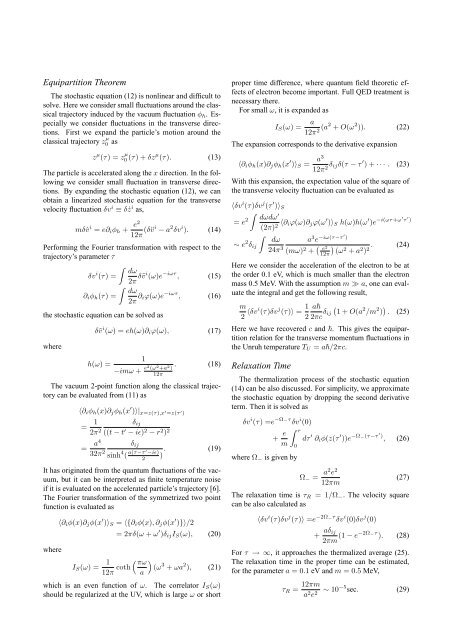Proceedings of International Conference on Physics in ... - KEK
Proceedings of International Conference on Physics in ... - KEK
Proceedings of International Conference on Physics in ... - KEK
Create successful ePaper yourself
Turn your PDF publications into a flip-book with our unique Google optimized e-Paper software.
Equipartiti<strong>on</strong> Theorem<br />
The stochastic equati<strong>on</strong> (12) is n<strong>on</strong>l<strong>in</strong>ear and difficult to<br />
solve. Here we c<strong>on</strong>sider small fluctuati<strong>on</strong>s around the classical<br />
trajectory <strong>in</strong>duced by the vacuum fluctuati<strong>on</strong> ϕh. Especially<br />
we c<strong>on</strong>sider fluctuati<strong>on</strong>s <strong>in</strong> the transverse directi<strong>on</strong>s.<br />
First we expand the particle’s moti<strong>on</strong> around the<br />
classical trajectory z µ<br />
0 as<br />
z µ (τ) = z µ<br />
0 (τ) + δzµ (τ). (13)<br />
The particle is accelerated al<strong>on</strong>g the x directi<strong>on</strong>. In the follow<strong>in</strong>g<br />
we c<strong>on</strong>sider small fluctuati<strong>on</strong> <strong>in</strong> transverse directi<strong>on</strong>s.<br />
By expand<strong>in</strong>g the stochastic equati<strong>on</strong> (12), we can<br />
obta<strong>in</strong> a l<strong>in</strong>earized stochastic equati<strong>on</strong> for the transverse<br />
velocity fluctuati<strong>on</strong> δv i ≡ δ ˙z i as,<br />
mδ ˙v i = e∂iϕh + e2<br />
12π (δ¨vi − a 2 δv i ). (14)<br />
Perform<strong>in</strong>g the Fourier transformati<strong>on</strong> with respect to the<br />
trajectory’s parameter τ<br />
δv i ∫<br />
dω<br />
(τ) =<br />
2π δ˜vi (ω)e −iωτ , (15)<br />
∫<br />
dω<br />
∂iϕh(τ) =<br />
2π ∂iφ(ω)e −iωτ , (16)<br />
the stochastic equati<strong>on</strong> can be solved as<br />
where<br />
δ˜v i (ω) = eh(ω)∂iφ(ω), (17)<br />
h(ω) =<br />
1<br />
−imω + e2 (ω 2 +a 2 )<br />
12π<br />
. (18)<br />
The vacuum 2-po<strong>in</strong>t functi<strong>on</strong> al<strong>on</strong>g the classical trajectory<br />
can be evaluated from (11) as<br />
⟨∂iϕh(x)∂jϕh(x ′ )⟩| x=z(τ),x ′ =z(τ ′ )<br />
= 1<br />
2π 2<br />
= a4<br />
32π 2<br />
δij<br />
((t − t ′ − iϵ) 2 − r 2 ) 2<br />
δij<br />
s<strong>in</strong>h 4 ( a(τ−τ ′ . (19)<br />
−iϵ)<br />
2 )<br />
It has orig<strong>in</strong>ated from the quantum fluctuati<strong>on</strong>s <str<strong>on</strong>g>of</str<strong>on</strong>g> the vacuum,<br />
but it can be <strong>in</strong>terpreted as f<strong>in</strong>ite temperature noise<br />
if it is evaluated <strong>on</strong> the accelerated particle’s trajectory [6].<br />
The Fourier transformati<strong>on</strong> <str<strong>on</strong>g>of</str<strong>on</strong>g> the symmetrized two po<strong>in</strong>t<br />
functi<strong>on</strong> is evaluated as<br />
where<br />
⟨∂iϕ(x)∂jϕ(x ′ )⟩S = ⟨{∂iϕ(x), ∂jϕ(x ′ )}⟩/2<br />
= 2πδ(ω + ω ′ )δijIS(ω), (20)<br />
IS(ω) = 1<br />
12π coth<br />
(<br />
πω<br />
)<br />
(ω<br />
a<br />
3 + ωa 2 ), (21)<br />
which is an even functi<strong>on</strong> <str<strong>on</strong>g>of</str<strong>on</strong>g> ω. The correlator IS(ω)<br />
should be regularized at the UV, which is large ω or short<br />
proper time difference, where quantum field theoretic effects<br />
<str<strong>on</strong>g>of</str<strong>on</strong>g> electr<strong>on</strong> become important. Full QED treatment is<br />
necessary there.<br />
For small ω, it is expanded as<br />
IS(ω) = a<br />
12π 2 (a2 + O(ω 2 )). (22)<br />
The expansi<strong>on</strong> corresp<strong>on</strong>ds to the derivative expansi<strong>on</strong><br />
⟨∂iϕh(x)∂jϕh(x ′ )⟩S = a3<br />
12π 2 δijδ(τ − τ ′ ) + · · · . (23)<br />
With this expansi<strong>on</strong>, the expectati<strong>on</strong> value <str<strong>on</strong>g>of</str<strong>on</strong>g> the square <str<strong>on</strong>g>of</str<strong>on</strong>g><br />
the transverse velocity fluctuati<strong>on</strong> can be evaluated as<br />
⟨δv i (τ)δv j (τ ′ )⟩S<br />
= e 2<br />
∫ ′ dωdω<br />
(2π) 2 ⟨∂iφ(ω)∂jφ(ω ′ )⟩S h(ω)h(ω ′ )e −i(ωτ+ω′ τ ′ )<br />
∼ e 2 ∫<br />
dω<br />
δij<br />
24π3 a3e−iω(τ−τ ′ )<br />
) . (24)<br />
(ω2 + a2 ) 2<br />
(mω) 2 + ( e 2<br />
12π<br />
Here we c<strong>on</strong>sider the accelerati<strong>on</strong> <str<strong>on</strong>g>of</str<strong>on</strong>g> the electr<strong>on</strong> to be at<br />
the order 0.1 eV, which is much smaller than the electr<strong>on</strong><br />
mass 0.5 MeV. With the assumpti<strong>on</strong> m ≫ a, <strong>on</strong>e can evaluate<br />
the <strong>in</strong>tegral and get the follow<strong>in</strong>g result,<br />
m<br />
2 ⟨δvi (τ)δv j (τ)⟩ = 1 a<br />
2<br />
2πc δij<br />
( 1 + O(a 2 /m 2 ) ) . (25)<br />
Here we have recovered c and . This gives the equipartiti<strong>on</strong><br />
relati<strong>on</strong> for the transverse momentum fluctuati<strong>on</strong>s <strong>in</strong><br />
the Unruh temperature TU = a/2πc.<br />
Relaxati<strong>on</strong> Time<br />
The thermalizati<strong>on</strong> process <str<strong>on</strong>g>of</str<strong>on</strong>g> the stochastic equati<strong>on</strong><br />
(14) can be also discussed. For simplicity, we approximate<br />
the stochastic equati<strong>on</strong> by dropp<strong>in</strong>g the sec<strong>on</strong>d derivative<br />
term. Then it is solved as<br />
δv i (τ) =e −Ω−τ δv i (0)<br />
+ e<br />
m<br />
∫ τ<br />
where Ω− is given by<br />
0<br />
dτ ′ ∂iϕ(z(τ ′ ))e −Ω−(τ−τ ′ ) , (26)<br />
Ω− = a2 e 2<br />
12πm<br />
(27)<br />
The relaxati<strong>on</strong> time is τR = 1/Ω−. The velocity square<br />
can be also calculated as<br />
⟨δv i (τ)δv j (τ)⟩ =e −2Ω−τ δv i (0)δv j (0)<br />
+ aδij<br />
2πm (1 − e−2Ω−τ ). (28)<br />
For τ → ∞, it approaches the thermalized average (25).<br />
The relaxati<strong>on</strong> time <strong>in</strong> the proper time can be estimated,<br />
for the parameter a = 0.1 eV and m = 0.5 MeV,<br />
τR = 12πm<br />
a 2 e 2 ∼ 10−5 sec. (29)













